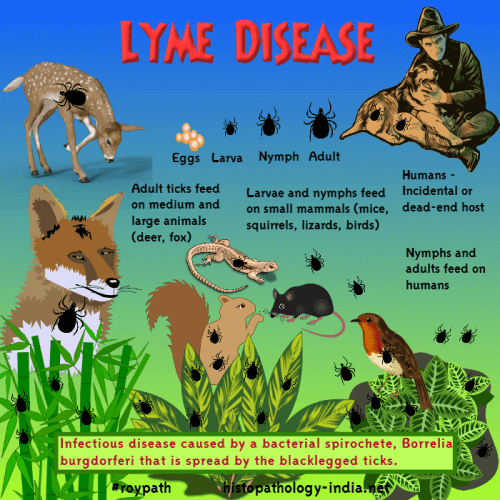|

Custom Search
|
|
Infectious Disease Online Pathology of Lyme Disease (Lyme Borreliosis) |

Borrelioses are an important group of spirochetal infection.Lyme disease or Lyme borreliosis, a tick-borne disease, is caused by Borrelia burgdorferi.
It comprises a wide spectrum of symptoms affecting skin, musculoskeletal system, heart, eyes, central and peripheral nervous system.Infection was first described in patients from Lyme, Connecticut, but was later recognized along the northeastern coast of the United States.Borrelioses are found in the temperate zones Europe, North America and Asia.Ticks of the genus Ixodes are infected while biting deer and mice.Three species of Borrelia burgdorferi have been identified as human pathogens : Borrelia burgdorferi sensu stricto, Borrelia garinii and Borrelia afzelii . " New bacteria has been discovered that causes Lyme disease. It is known as Borrelia mayonii, named after Mayo Clinic, where it has been identified." Three days to four weeks after inoculation, a papule develops. A ring-like rash expands outward from the site of the bite and lasts from a month to a year. The majority of patients suffer from migratory polyarthritis, which may develop into chronic arthritis. Myocarditis and neurologic symptoms are seen in a minority of patients. Manifestations of Lyme carditis include atrioventricular block, myopericarditis, intraventricular conduction disturbances, bundle branch block and congestive heart failure. Diagnosis is made by associating the clinical and historical features of borreliosis, such as previous tick bite, electromyography, or neurologic involvement, with electrocardiographic abnormalities and symptoms such as chest pain, palpitations, syncope, and dyspnea. Serologic studies and endomyocardial biopsy can support the diagnosis in the correct clinical setting. About 80% of all Lyme borreliosis cases represent skin manifestations (dermatoborrelioses). The three characteristic dermatoborrelioses are erythema chronicum migrans, borrelia associated B-cell Lymphoma, and acrodermatitis chronica atrophicans, which occur in different stages of the disease. Erythema migrans is the hallmark of early Lyme borreliosis, whereas acrodermatitis chronica atrophicans is the characteristic manifestation of late Lyme borreliosis. Several spirochetal factors (Example: infection with different genospecies, co-infection with other tick-transmitted pathogens) as well as host factors (Example: cytokine patterns at the site of infection) influence the course of the disease. The papule shows acanthosis and necrosis of keratocytes in the epidermis. In the dermis and synovium, lymphocytes and histiocytes infiltrate neurovascular spaces. Spirochetes are found in vessel walls. Association of infection with Borrelia burgdorferi and primary cutaneous B-cell Lymphoma (PCBCL): Borrelia burgdorferi has been identified within lesional skin of patients with primary cutaneous B-cell Lymphoma either by culture or PCR. It has been suggested that Borrelia burgdorferi - associated PCBCL arises from chronically stimulated lymphoid tissue acquired in response to Borrelia burgdorferi infection in a manner similar to gastric Marginal zone lymphoma and Helicobacter pylori infection. PCR analysis of Borrelia burgdorferi DNA is a fast test that should be performed in all patients with PCBCL to identify those who more likely could benefit from an early antibiotic treatment. The organisms are grown from blood, cerebrospinal fluid, and skin specimens. Diagnosis in the early stage of Lyme borreliosis relies on the clinical picture, whereas serological, molecular, microbiological, and histopathological findings are important adjuncts in the diagnosis of later stages of the infection. Penicillin V and tetracycline shorten the duration of the illness. Antibiotic treatment is necessary for all stages and manifestations of Lyme borreliosis. Doxycycline is the antibiotic of choice for most patients with dermatoborrelioses. Adequate antibiotic therapy cures more than 90% of the patients. However, in some patients repeated therapy is necessary and a small number of patients develop chronic arthritis or other features. While there is currently no vaccine available, prevention of tick bite is the most effective prophylaxis. Visit: Erythema chronicum migrans ; Acrodermatitis chronica atrophicans. Pathology of Neuroborreliosis: Human infection by Borrelia burgdorferi, the etiological agent for Lyme disease, can result in serious acute and late-term disorders including neuroborreliosis, a degenerative condition of the peripheral and central nervous systems. Usually patients develop a lymphocytic meningitis, radiculoneuritis or cranial neuropathy, occurring singly or in combination. Patients with radicular involvement often have a myelopathic component as well. Rarely patients develop focal inflammation of the central nervous system, an encephalomyelitis, that appears to involve white matter more often than grey. Often patients may develop cognitive and memory impairment-a mild encephalopathy. In some patients this may represent a subtle form of encephalomyelitis, while in others it is probably a "toxic-metabolic" effect of systemic infection. |
|
|


